3306
Views & Citations2306
Likes & Shares
Findings: I have found that about eight crore tourists should visit Jammu and Kashmir per year as per its Carrying Capacity, which means Jammu and Kashmir's environmental carrying capacity has not reached the threshold limit. I have also found that 112841 tourists can visit daily or within 24 h, 3385230 tourists can visit per month, and 41186965 tourists can visit yearly to Jammu and Kashmir. That means Jammu and Kashmir have enough accommodation facilities and can provide accommodation facilities for up to 412 lakh tourists because our flow is near about 200 lakhs only. Finally, I have concluded that Jammu and Kashmir have excellent tourism potential. It can increase tourist arrivals to a large extent by promoting it across the country and outside the country.
The practical implications: This study enables the policymakers to obtain the necessary evidence on the Carrying capacity of the tourism environment of Jammu and Kashmir. It also informs them about implementing an adequate policy to invite an optimal number of tourists.
Originality: Literature has been reviewed, I found that very few studies have focused on this issue. The authorities must be aware of the carrying capacity of the tourism environment of Jammu and Kashmir because it leads to environmental degradation after the inflow of visitors crosses the threshold limit.
Research limitations: The study has many limitations, most of which twig from the problem that the data was not in one place and was not sufficient for the extensive research on this theme.
Keywords: Tourism in Kashmir, Tourism environment, Carrying capacity
This bosom relation of the natural environment and tourism stretches a new concept of "Tourism Environment." Tourism means traveling to or staying in places outside their usual environment for not more than a consecutive year and not less than 24 h for leisure, pleasure, business, and other purposes (UNTWO). On the other hand, "Natural environment could be defined as the physical, chemical and biological surroundings that humans and other species dependent on as a life support" (Hussain, 2004). For this study, environment simply means the surroundings in which life exists. A 'Tourism Environment' is an environment where tourism exists and includes all-natural, synthetic, and symbiotic products that provide tourism-related services at a destination. Thus, it has three components, viz., Natural, Synthetic and symbiotic elements. Their mélange forms the tourism environment. Travel agencies, the transport sector, the hospitality sector, entertainment, recreation, the natural environment (tourist attractions), tourists, security, tourism goods, travel agents are all the components of the tourism environment. The natural environment, tourism base, and a valuable tourist attraction source are part of the tourism environment. The tourism environment includes critical elements of a natural environment as the prime attraction, Synthetic Environment, Symbiotic Environment, an optimum number of eco-friendly visitors, travel agents, transport sector, hospitality sector, and entertainment activities (Kumar, 2018). Rodday, Biwal, & Joshi, (2009) called these components as tourism products. Han & Ryu, (2009), Bitner, (1992) Reimer & Khan, (2005), Booms & Bitner, (1982), Wakefield & Blodgett, (1996) mentioned that researches in environmental Psychology found that human behavior is highly influenced by and is strongly associated with the physical or synthetic environment. They also mentioned it is incumbent upon the firms or marketers to make their physical environment more pleasant, innovative, healthy, and attractive. Because customers intentionally or unintentionally sense the physical environment before, during, and after visiting any business unit, particularly in restaurants and hotels. Applying structural equation modeling, they found that décor and artifact, spatial layout, and ambient conditions significantly affected price perception, whereas décor and artifacts significantly influenced customer satisfaction. He also found that both Price perception and customer satisfaction are essential predictors of customer loyalty. Chang, (2009) applying structural modeling, found a causal relationship between the physical environment and customer satisfaction, and customer satisfaction has a significant impact on the return intentions of the customers. Some other studies, such as Ali, Amin & Ryu, (2015), Mehrabian & Russel, (1974), Dareley & Gilbert, (1985), Holahan, (1986), Russel & Parrat, (1980), Tam, (2010) posited that previous consumption patterns and customer satisfaction mainly influence customer satisfaction and superficial values. The outcome of this previous consumption experience is an important factor in future profitability. Lancaster, (1960) in his theory of consumer behavior, he Posited that consumers do not receive utility directly from goods and services; instead, they derive utility from attributes or characteristics of these goods and services. Before him, most economists, especially Marshall and others, posited that consumers directly get satisfaction from consuming goods and services. Similarly, as Lancaster has mentioned above, Negre, Hernandez & Moreno-Gil, (2018) suggested that leisure actives, the inward attributes of tourist destinations, are essential determinants of tourist expenditure patterns. They found that the number and types of activities available at a tourist destination significantly impact tourist expenditure patterns. The tourist who performs fewer activities spends less than those who perform more activities. They also found that some activities generate less Income than others. This difference is created by time constraints that mean the time spent by a tourist on his performing activity. If he spends more time performing an activity, he will spend more on that activity and spend more time and money at a destination. So, it is necessary to increase the number of tourist spots and increase the number of leisure activities which generate revenue in the future. Bishoyi, (2007) & Tisdell, (2003) posited that the environment provides an impotent role in tourism. Without this, the word tourism would not exist. Therefore, most economists found it necessary to assess the economic value of natural resources. Randall & Stoll, (1983) first used the concept of total economic value. In environmental economics, mostly suggested methods to value natural resources are the Contingent Valuation method, Travel Cost and Hedonic price methods, etc. Hussain & Islam, (2017) mentioned that tourism could be the best opportunity for revenue maximization if properly managed, maintained, and developed. The Contingent Valuation Method (Willingness to pay method) and Travel Cost Method found that consumer surplus value varies from 1.24 to 3.24 US $ per person and Willingness to pay varies from 0.06 to 0.10 US $ per person in four tourist spots under his study domain. The estimated recreational value ranges from 0.06 to 0.84 million US $ under the Travel Cost Method and ranges from 0.002 to 0.029 million US $ Contingent Valuation Method. These positive recreational values suggested that these tourist spots have a great potential for generating benefits for the economy. Therefore, it is incumbent upon the government or policymakers to develop these tourist spots in more, better, and more modern way and some policy initiatives must be to taken to explore such more tourism spots and generate more benefits from them. Political stability is a necessary and sufficient condition for promoting tourism at a destination. It has been observed that tourism is the consequence of peace. If there is peace, tourism will automatically boost. Parida, Bhardwaj & Chowdhury, (2017) mentioned the economic development and tourism promotion policies in India have attracted a large number of tourists. Still, at the same time, the increasing trend of crime rates and uncertainty had strongly halted the way of its development. Sustainability is an essential and sufficient condition for preserving tourism and tourism spots at a destination. In their book, Singh & Dowling, (2003) mention that the Universal Declaration of Human Rights of December 10, 1948, tourism is a universal and fundamental right of all citizens of the world. Ever since tourism is growing dramatically, new records in tourist arrivals, receipts, and expenditures were reached, each year increasing upon the previous. Brown, (1997) posited that this growing tourist arrival is fair but not free from disadvantages. It leads to severe consequences for the environment of the host country. To overcome these harmful effects on tourists, a carrying capacity strategy was suggested by some studies (Brown, 1997). Carrying capacity and openness are two important strategies useful in analyzing environmental and social impacts of tourism. The unite Nations World Tourism Organization (UNWTO) mentioned in their 1992 report that carrying Capacity is the visitor's use of an area with a high level of satisfaction and minimum impacts on resources (Bishoyi, 2007).
METHODOLOGY
Secondary data has been used to fulfill the objectives of the study. The data has been collected personally from the offices of the Director Tourism Kashmir, Director Tourism Jammu, and Director Floriculture Kashmir. I have also used annual reports of the few departments and the significant works of different authors. For the data analysis, the method of carrying Capacity has been used.
Carrying Capacity
Jammu and Kashmir possess a great tourism potential in terms of gorgeous natural environmental resources and tremendous synthetic and elegant symbiotic environmental resources, which play an essential role in the state's substantial tourism and economic development. But serious thought is needed for its sustainable development. Among the most important requirements for its sustainable development, securitization of the carrying capacity of the tourism environment is essential because its negligence will persistently show the signs of degradation and pollution. Bishoyi, (2007) in his book quotes that Brown, (1997) posited that this growing tourist arrival is fair but not free from disadvantages. It leads to severe consequences for the environment of the host country. Wall, (2019) while applying the concept of Carrying Capacity, mentioned that "over-tourism is not a new concept. It has a long history, and this issue attracts large attention to the need for careful planning and management of tourism, as well as respect for the residents of the tourist destinations". Some studies suggested overcoming these harmful effects of tourist carrying capacity strategy. Brown, (1997) Carrying capacity and openness are essential strategies for analyzing tourism's environmental and social impacts. The United Nations World Tourism Organization (UNWTO) mentioned in their 1992 report that carrying Capacity is the visitor's use of an area with a high level of satisfaction and minimum impacts on resources. Boulding, (1985) carrying Capacity and can be calculated by the formula given below".
The minimum tourist spot area per tourist, 50m2 of the total tourism area, has been used as a standard to measure Jammu and Kashmir's carrying capacity. Tantrigama (1998) posited that three types of carrying capacity strategies are commonly used for analytical purposes, which are given below.
Ecological carrying capacity refers to the maximum number of tourists that an area can absorb before an ecological decline occurs.
Physical carrying capacity refers to the ceiling on tourist arrivals that a resource can cope with. It includes accommodation, catering, amenities, and transport facilities besides electricity, water supply, etc.
Environmental carrying capacity refers to the maximum number of tourists that an area can accommodate without harming the environment.
It is essential to note here that, in my view, both ecological and environmental carrying capacities are the same. Therefore, this study has the same meaning, and both of these terms have been used simultaneously. In this study, physical carrying capacity has also been used.
Natural Environment
The natural environment includes all the forest areas, water bodies, flora and fauna, deserts, wetlands, and the climate of any region, state, or country.
Table 1 given below shows that the Jammu region has the highest forest cover as compared to other geographical areas. It has about 51% of forest area, followed by Kashmir valley, which has about 46% forest area, while Ladakh has only 0.06% of forest area. But there arise few questions Viz.
- Whether this whole forest area can be used for tourism or not?
- Whether this forest area is feasible and accessible to travel or not?
- Whether this area has tourism potential or not?
- And finally, whether this area has a carrying capacity of bearing the burden of tourist flow?
- If so, how much flow can we bear so that we can sustain this area for the future?
These all questions need a greater apprehension. Before throwing much light on this topic, we will first elucidate the other categories of forest classified by the department of forestry from time to time that will clearly help us understand and answer the above questions. The forest cover of Jammu and Kashmir has been classified on the basis of the canopy density, viz. very dense forests, moderately dense forests, and open forests.

Table 2 below shows that most of the forest area is open. About 46% of forest area is open, 36% are moderate forests, and 17% are very dense forests. Now we can understand that 53% of forest area is not feasible and accessible to travel or tourism. Because 17% of very dense forests are not achievable, 36% of moderate forests are not accessible to travel. Only 46% of open forests can be used for travel and tourism, which is feasible and accessible. But there is another issue that further needs to be understood is that among 46% forest area that is 10587 Sq. kms only 7165 Sq. kms of the forest area is inside the actual line of control (LOC), and the rest 3422 Sq. kms are outside the line of control. Therefore, it is clear know that only 7165 Sq. kms, which is about 31% of the total forest area (23241 sq. kms) can be used for tourism and travel purposes. But there is another issue most of this land is under army occupation, and some of it is used to construct hotels on reference bases that I have observed from time to time. Some of it is unutilized for tourism purposes. Now to promote tourism and attract a massive number of visitors, we must develop and décor this forest area. We can also use some areas from moderate forest cover by exploring, expanding, and making them feasible and accessible.
Besides this forest area, we have many wildlife sanctuaries and national parks. These national parks and wildlife sanctuaries have a great tourism potential if being promoted and developed. At present, we 5 national parks, 14 wildlife sanctuaries, 8 conservation reserves, 8 protected area parks (which may be included in the forest area), and 14 wetland reserves. Their area-wise description is given below in Table 3.

It shows that we have only five national parks with an area of 6830.07 sq. kms, which is about 6.74% of the state's actual geographical area (101387 sq. kms). Besides this, the table shows that we have 14 wildlife sanctuaries with 799.38 sq. kms, 8 protected area reserves with an area of 521.192 sq. kms and 8 conservation reserves with an area of 269.25 sq. kms. It also shows that in total, we have 8419.90 Sq. kms protect conservation reserves, which is about 8.45% of the state's actual geographical area (101387 sq. kms). Besides this, we have 14 wetland reserves with an area of 156.27 Sq. kms and 1230 water bodies can also be used for tourism. Their area-wise description is given in Table 4 given below. It shows that Ladakh has a greater number of water bodies.


Symbiotic Environment
Besides this natural environment, erstwhile Jammu and Kashmir have a good symbiotic environment. A symbiotic environment is a combination of products created by blending natural attractions and built attractions. These products include parks, gardens, etc. Jammu and Kashmir State is world-famous for its Mughal gardens and splendors.
The area-wise description of some gardens is given in Table 5. It shows that the Kashmir region has the most significant number of parks and gardens. Ladakh and Jammu regions have fewer gardens and parks. It shows that the tulip garden in Srinagar has the highest area used for tourism, which is Asia's most extensive tulip garden. According to the floriculture department, the garden was visited by 2.59 lakh tourists within 29 days in 2019 and generated 79 lakh rupees from the entry tickets. From this, it can be understood how important and economical these symbiotic products are. With the development and promotion of these gardens and parks, the state would collect huge revenue that can be used for further development of the state.
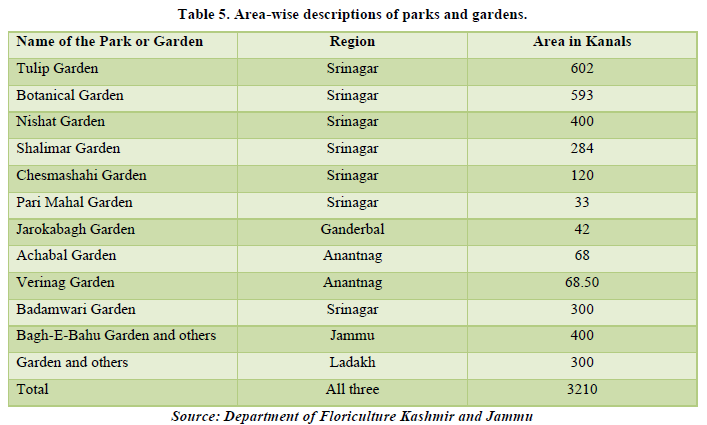
Environmental Carrying Capacity
Environmental carrying capacity refers to the maximum number of tourists that an area can absorb before ecological decline takes place. It has been observed above that among natural Environment 7165 sq. kms, which is about 31% of the total forest area (23241 sq. kms) can be used for tourism and travel purposes. Erstwhile, Jammu and Kashmir have an area of 755 sq.kms under water bodies and about 1.63 sq.kms (3210 kennels) under a symbiotic environment, which is a good source of tourism attraction. Erstwhile Jammu and Kashmir also have an area of 8420 sq.kms under national parks, wildlife sanctuaries, conservation reserves, and protected areas. But there is an issue most of this land is under army occupation; some of it has been used to construct hotels on reference bases that have been observed during the field survey, and some of it is not utilized for tourism purposes. By considering these issues, if we assume that only half of the forest area can be used for tourism and we assume that area under conservation reserves may be included in forest area, and we leave the area under wetlands, and we also assume that only half the area under water bodies can be used for tourism we still have a very good amount of land and water resources that can be used for tourism. Half of the forest area is 3582sq.kms, half of the area's underwater resources are 377sq.kms, and the area under a symbiotic environment is 1.63sq.kms.If these figures are added, we get the area that comprises our total environment available for tourism.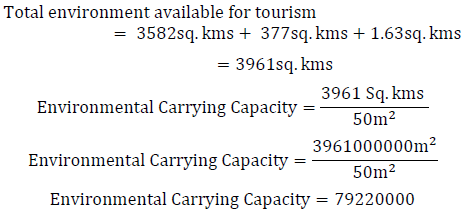
It can be inferred that about eight crore tourists are allowed to visit Jammu and Kashmir per year if this area is brought under the tourism map. During 2019, the total number of tourist visits to Jammu and Kashmir was 17215468. Therefore, we can conclude that carrying Capacity has not exceeded during 2019. It can also be inferred from this that the environmental carrying capacity of Jammu and Kashmir has not reached the threshold limit. Therefore, Jammu and Kashmir have great tourism potential, and it can increase tourist arrivals to a large extent by promoting it across the country and outside the country. It is important to note here that before the promotion, we must develop and décor this natural environment by making it accessible, attractive and affordable to all types of tourists.
Synthetic Environment
Another part of the tourism environment is the human Environment or manmade Environment. It includes all physical infrastructure of a destination such as accommodation facilities, roads, transport facilities, catering services, entertainment and recreation centers, theme parks, shopping and market facilities, etc. Human-made products also include fairs and festivals, cuisine, architecture, monuments, etc. are also created products that offer a wide range of services for pleasure, leisure, or business. It also includes both internal and external political stability at the destination. Tourism is a national asset. However, it depends upon good international relations among nations with minimum entry to enter in terms of permits, visas, currency language, etc. (Roday, Biwal & Joshi, 2009).
Tourism and Accommodation preferences
After reaching their preferred destinations, tourists need accommodation facilities for lodging, boarding, and resting purposes. A. K Bhatia, (2014) mentioned that accommodation plays a central and distinctive role in the tourism industry. It has been observed that tourists usually prefer clean, hygienic, and affordable accommodation. Table 6 below shows the accommodation facilities available for tourists in Jammu and Kashmir. It shows that the 4486 accommodation facilities are available for visitors with a total bed capacity of 112841 in erstwhile Jammu and Kashmir State. In which 2685 accommodation facilities are available in Kashmir valley with a total bed capacity of 62542 beds, 898 accommodation facilities are available in Jammu with a total bed capacity of 36004 beds, and 903 accommodation facilities are available in Ladakh region with a total bed capacity of 14295 beds. It also shows that 315 A grade accommodations with a total bed capacity of 17663 beds; 319 B grade accommodations facilities with a total bed capacity of 10275 beds; 107 C grade accommodations facilities with a total bed capacity of 45391 beds; 1945 guest houses with a total bed capacity of 34900 beds and 910 houseboats with a total bed capacity of 4612 beds are available in erstwhile Jammu and Kashmir.
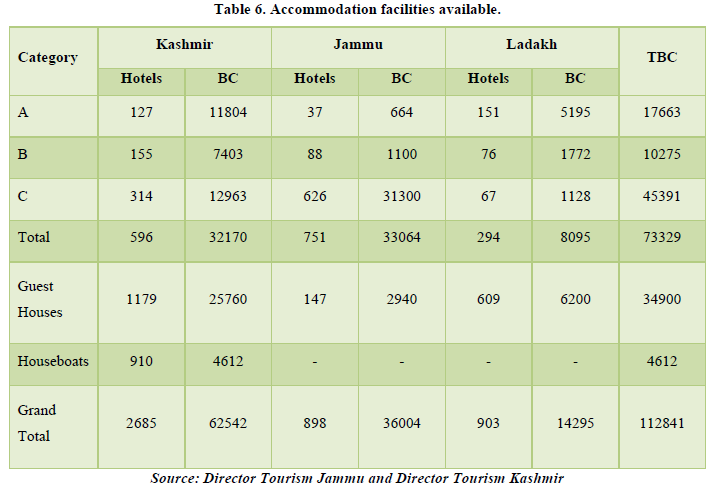
Table 7 below shows the performance of accommodation facilities provided by the Jammu and Kashmir tourism development corporation. It indicates that, on average, 50% of accommodation facilities remain vacant during this decade in the Kashmir region. The table also shows that, on average, 50% of accommodation facilities remain vacant during this decade in the Jammu region.
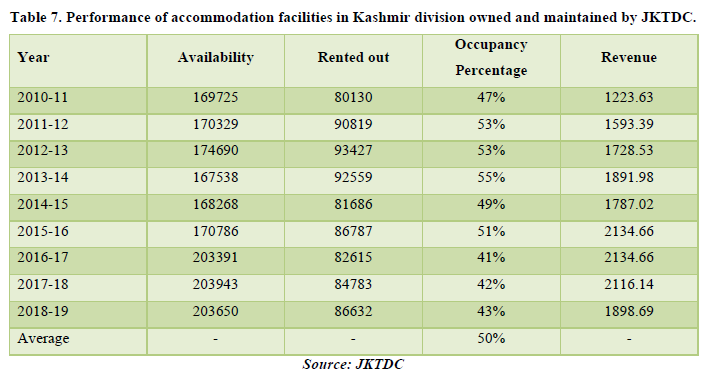
Table 8 below shows the performance of accommodation facilities provided by the Jammu and Kashmir tourism development corporation in Ladakh. It indicates that on average, 88% of accommodation facilities remain Vacant during this period in the Ladakh region.
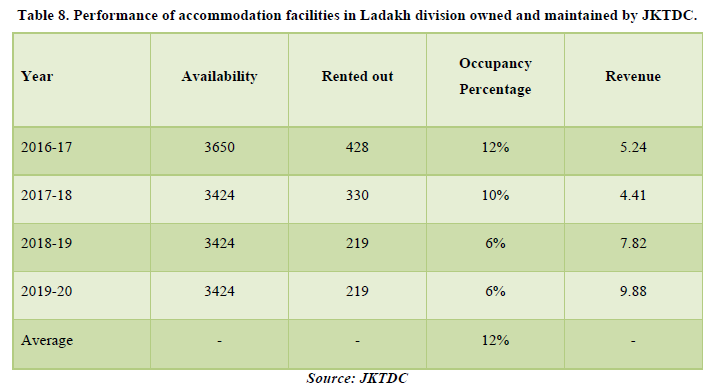
Table 9 given below shows the performance of accommodation facilities provided by the Jammu and Kashmir tourism development corporation in Jammu. It indicates that on average, 50% of accommodation facilities remain vacant during this period in the Jammu region.
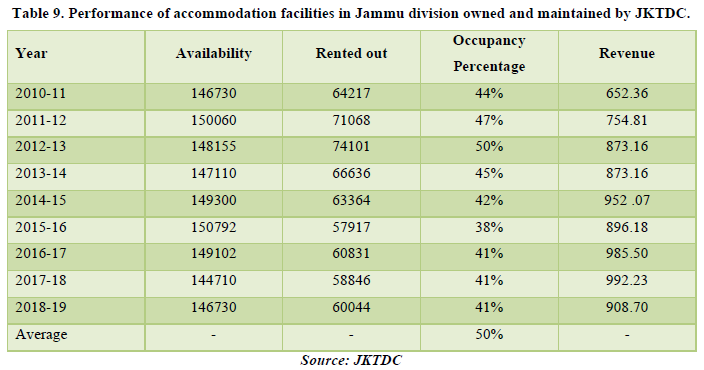
Carrying Capacity
Physical carrying capacity refers to the ceiling on tourist arrivals that a resource can cope with. It includes accommodation, catering, amenities, and transport facilities besides electricity, water supply, etc. Unite Nations World Tourism Organization (UNWTO) mentioned in their 1992 report that carrying Capacity is the level of visitor's use of an area with a high level of satisfaction and minimum impacts on resources (Bishoyi. D., 2007). Minimum tourist spot area per tourist bed may have been used as a standard to measure the state's carrying capacity.
Based on those mentioned above standard one-bed space per tourist is required to provide accommodation to every tourist. The maximum number of tourists allowed to visit at a point of time to Jammu and Kashmir state is:
That means that Jammu and Kashmir have 112841 beds available for tourists at a point in time. Usually, hospitality managers take 24 h to check out from an accommodation facility. Suppose a tourist’s checkout from an accommodation facility within 24 h; he has to pay the rent only for a night. In that case, otherwise, he may be charged for the second night if he is checking out from an accommodation facility after 24 h. Therefore, we say that one day stay or one-night stay is equal to 24 h. Thus, we can say that Jammu and Kashmir have 112841 beds available for tourists per day. If we take this observation as a base, we can calculate how many tourists can visit Jammu and Kashmir per day in the same way for a month and consequently for a year. That means 112841 tourists can visit Jammu and Kashmir daily or within 24 h. If this amount is multiplied by 30 days, we get the figure for the one month:
If this amount is multiplied by 365, we get the figure for the year:
It shows that 3385230 tourists can visit per month to Jammu and Kashmir. It also shows that 41186965 tourists can visit yearly to Jammu and Kashmir. If we look at the tourist arrival figure of the year 2018, we can see that only 17215468 tourists visited Jammu and Kashmir in 2018. That means we have enough Capacity for accommodation facilities, and we can provide accommodation facility up to 412 lakh tourists, but our flow is near about 200 lakhs only. So, this whole analysis of accommodation highlights that we do not need more accommodation facilities until our tourist flow crosses the figure of 412 lacs mark.
CONCLUSION
This study concluded that Jammu and Kashmir's environmental carrying capacity had not reached the threshold limit of natural and symbiotic environments. Therefore, Jammu and Kashmir have great tourism potential in its natural and synthetic environments. It was also concluded that Jammu and Kashmir have enough of Capacity of accommodation facilities, and it can provide accommodation facility up to 412 lakh tourists. Still, our flow is near about 200 lakhs only and. So, this whole analysis of accommodation highlights that Jammu and Kashmir have great tourism potential in terms of synthetic environment. Therefore, it did not need more accommodation facilities until the tourist flow crosses the figure of 412 lacs mark. Therefore, a complete ban should be imposed on the construction of hotels in the whole of Jammu and Kashmir, particularly around tourist destinations and in forest areas. Instead, some incentives should be given to these hoteliers to develop modern facilities in these accommodation facilities so that tourists should not feel any kind of dissatisfaction.
Finally, it was also concluded that Jammu and Kashmir have great tourism potential. It can increase tourist arrivals to a large extent by promoting it across the country and outside the country. It is important to note here that before the promotion, Jammu and Kashmir authorities must develop and décor this tourism environment by making it accessible, attractive and affordable to all types of tourists.


